Most of the spiders that you have encountered have probably been in the corner of your house and looked rather brown and undistinctive. Actually, spiders are extremely diverse; they live in almost every part of the world. They have different, inventive ways of living and catching their food.
The photographer Nicky Bay opens the window to the often overlooked world of spiders by taking close-ups of them and other tiny creatures. He scours forests, mainly around his home base of Singapore, looking for interesting critters. He finds beauty in a group that is often overlooked. Altogether, Nicky has snapped thousands of stunning arachnids (and other insects, etc). Here are just a few of the most breath-taking.
Mirror spider (Thwaitesia sp.)
This stunning spider’s abdomen is studded with lots of little mirror-like plates. The plates are likely made from guanine crystals, which provide colour to some arthropods. According to Nicky Bay’s observations, they don’t always stay the same size. When the spider moves or is agitated, the plates shrink to look like little glass shards. When the spider rests, the mirrors expand to become larger.

A spider that has been resting for almost an hour has silver plates that cover its entire abdomen, creating a mirror-like surface.
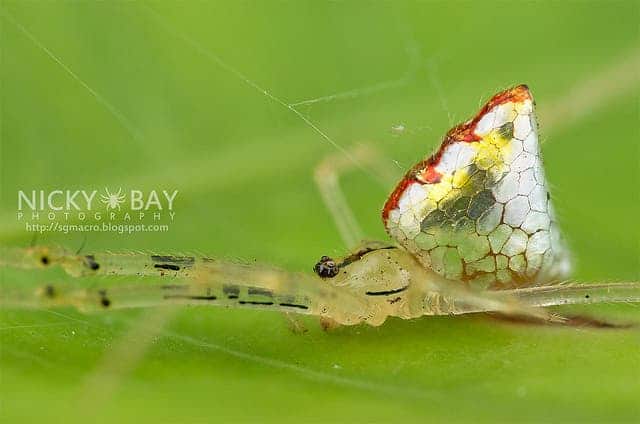
Tree stump orb weaver spider (Poltys sp.)
There are different ways to adapt to your surroundings. This orb weaver blends into its environment by being wood-coloured and having a knob that looks like the end of a branch. They stay still and are camouflaged by day so they seem like nothing more than a piece of wood. It’s a different story at night, they are active and build orb webs to catch their favourite, prey, moths.
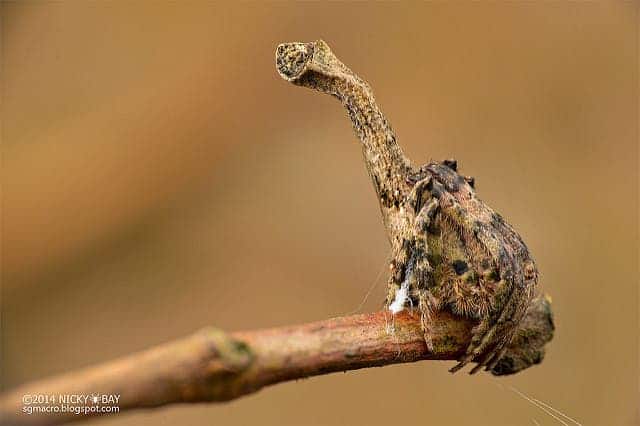
Here are two more tree stump orb weavers that are perched on the tip of a branch and are blend into the wood so well that they can barely be seen.

Lynx spider (Hamadruas sp.)
Lynx spiders spend most of their lives on a plant and ambush incoming prey. They can be identified by the pronounced bristles on their legs. Here is a mother lynx spider surrounded by her young offspring. Both parent and young are sporting stylish lime-green accents.
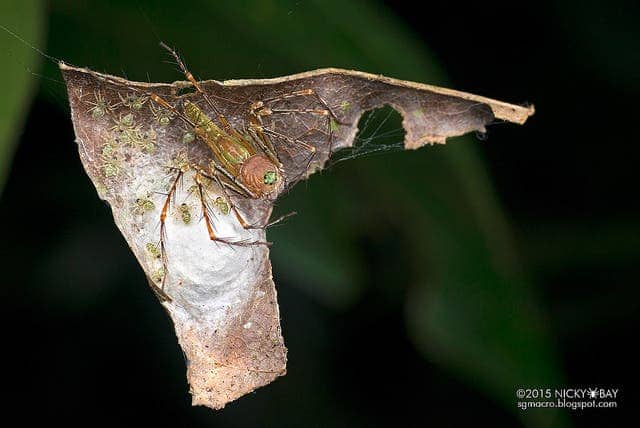
Broad-headed bark spider (Caerostris sp.)
With its small eyes and big head, this spider is surprisingly cute. It wraps its legs around branches and is coloured like bark in order to blend in and be less obvious to predators.

Many spiders glow under UV light, and this bark spider is not an exception. Here is different specimen whose bright blue colour is revealed under ultraviolet light.

Red ladybird mimic spider (Paraplectana sp.)
Although it looks strikingly like a ladybug, this spider is actually a classic case of Batesian mimicry. The red body and black spots on real ladybugs warn predators that they have a nasty taste. Spiders don’t actually taste bad but they fool predators into thinking that they do. The colour could also serve a sign of danger point blank that animals would instinctively stay away from.
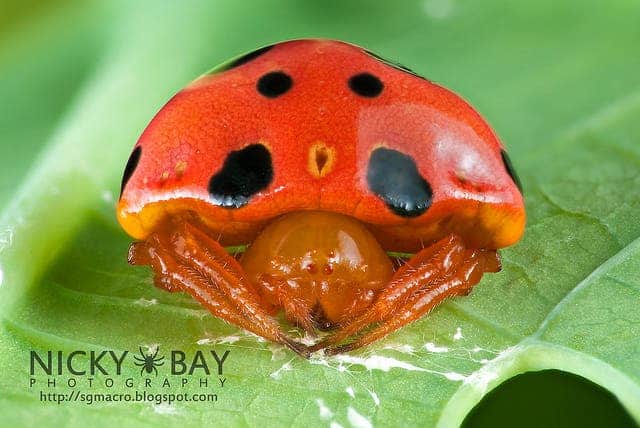
Long Horned Orb Weaver (Macracantha arcuata)
This spider has some of the longest horns of any spider. Who knows what their actual use is, if any, but they sure are impressive. One theory is the horns intimidate predators, but their purpose has not been confirmed. The horns are actually too heavy for the spider to stand upright on its own, so this angle (upside-down) is the spider’s natural one.

Ant-mimic jumping spider
Is it a regular ant? Count the number of legs. It’s actually a jumping spider that is mimicking an ant. Many spiders mimic ants, usually for two main reasons. The first reason is for defense. Ants are usually aggressive and known by predators (like birds) not to taste too good. Some ant mimics even join the ant colony so that predators, like wasps, leave them alone. However, most spiders mimic ants in order to get real ants as food. They pretend to be ants and even act like them. Once they get close to the ants, they snatch one for a meal.

The head shot below shows how the spider lifts up its front two legs to look like antennae. However real ants should be wary, the imposter jumps at the sight of prey and can weave a web quickly.
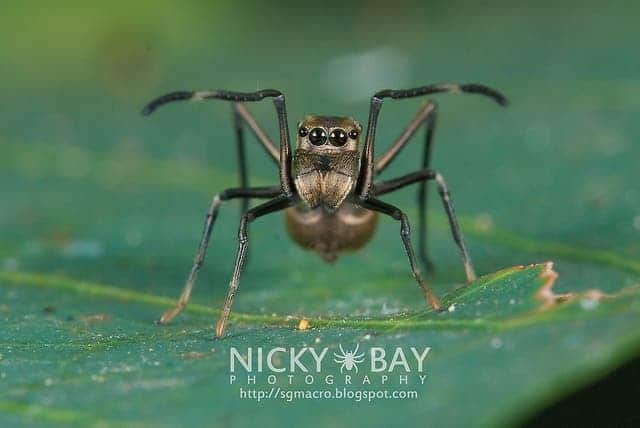
Red tent spider (Cyrtophora unicolor)
Although this spider looks like a giant hanging tent, it’s called a tent spider because of the shape of its web. It makes a 3D non-sticky web that looks somewhat like a tent. Nicky Bay used an extreme wide angle close up to exaggerate the spider’s size, so it’s actually less than 2 cm (0.8 inches) large. The bumps on the abdomen look like hundreds of eyes but are actually just bumps.
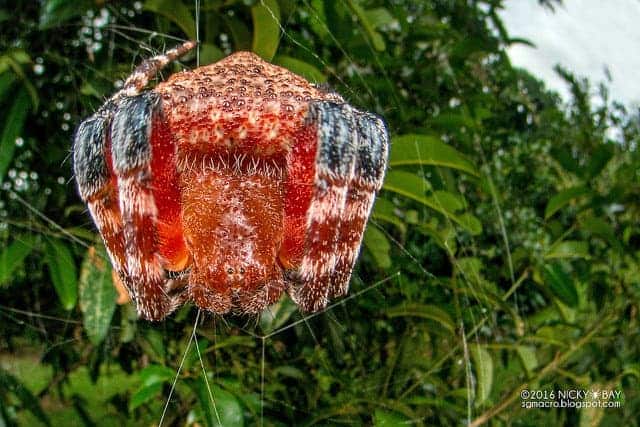
Jumping spider (Cosmophasis sp.)
Jumping spiders are among some of the most charismatic spiders. Their large eyes and head cock give them an inquisitive look. Because of their large eyes, they have very good vision and actively hunt their prey. They don’t make webs to catch they prey but do use silk to help capture food, as well as their jumping skills.
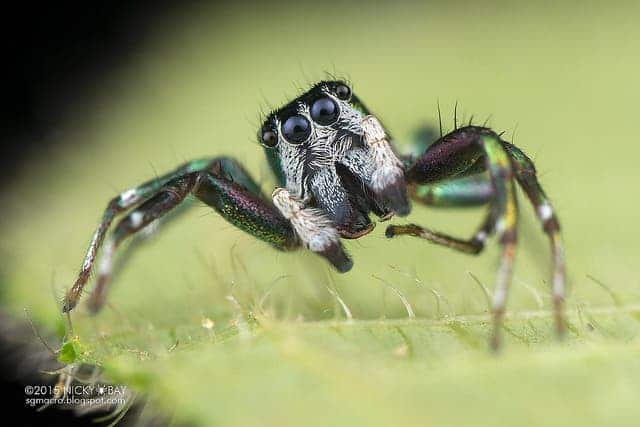
Did you ever think that spiders could look like that? There is way more to spiders than your average house spider!



